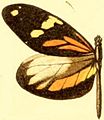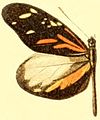Dismorphia amphione
| Dismorphia amphione | ||||||||||||
|---|---|---|---|---|---|---|---|---|---|---|---|---|

Dismorphia amphione (male) |
||||||||||||
| Systematics | ||||||||||||
|
||||||||||||
| Scientific name | ||||||||||||
| Dismorphia amphione | ||||||||||||
| ( Cramer , 1779) |
Dismorphia amphione is a butterfly from the family of Whites (Pieridae). Their wing shape is unusually long and narrow for whites.
The species is easy to confuse with the butterflies of the genus Heliconius or Ithomiini . This is supposed to simulate the toxicity of the animals to predators. This butterfly is the first species in which this type of deception ( mimicry ) has been detected.
features
butterfly
The moths are between 40 and 45 millimeters long, sometimes up to 77 millimeters. Other sources cite a wingspan of 70 millimeters for females and 80 millimeters for males. Their wings are patterned in black, orange and yellow and their drawing is very variable. The forewings are usually orange-black at the base and turn more and more yellowish towards the wing tips. The hind wings are rather dark and have a large orange spot in the female and an orange stripe in the male. In the front area of the hind wing, the males have a white to silvery spot, which the females lack.
Caterpillar
The body of the caterpillars is dark green.
Behavior and way of life
The females lay their eggs on the forage plant, one egg on each leaf. The caterpillars feed on Inga sapindoides , Inga densiflora and other species of the genus Inga as well as on acacias (Acacieae). There are caterpillars that only eat fresh leaves and others that only eat older leaves.
distribution and habitat
The species occurs in South and Central America from Mexico to Brazil and Bolivia and from Peru to Guyana . In the West Indies , the species inhabits Cuba and the island of Hispaniola , Trinidad and Puerto Rico . It prefers tropical forests and lives here on the edge of the forest at heights of up to 1000 meters.
Subspecies
In addition to the nominate form D. amphione amphione from French Guiana and Suriname , a distinction is made between the following subspecies:
- D. amphione spio ( Godart , 1819) - on the islands of Hispaniola and Puerto Rico. Both sexes differ greatly in the variability of the coloration from deep orange to bright yellow. In the eastern part of Hispaniola the moths are usually larger than in Haiti and tend to be more orange in color.
- D. amphione astynome ( Dalman , 1823) - in the Brazilian states ( São Paulo , Bahia and Minas Gerais ) to Argentina
- D. amphione praxinoe ( Doubleday , 1844) - in eastern Mexico via the Chiriquí province to Panama and Colombia
- D. amphione beroe ( Lucas , 1852) - from Panama to Colombia
- D. amphione egaena ( Bates , 1861) - in the Brazilian state of Amazonas
- D. amphione cubana ( Herrich-Schäffer , 1865) - on the island of Cuba
- D. amphione discrepans ( Butler , 1896) - in Ecuador . With very narrow yellow spots instead of a yellow band.
- D. amphione rhomboidea ( Butler , 1896) - from Ecuador to Peru
- D. amphione broomeae ( Butler , 1899) - from Venezuela to the island of Trinidad
- D. amphione meridionalis ( Röber , 1909) - in Bolivia. Has two yellow dots in the front area on the underside of the forewings and a yellow central wide band that does not touch the reduced red-brown markings.
- D. amphione daguana ( Bargmann , 1929) - in Colombia
- D. amphione lupita ( Lamas , 1979) - in the northwestern Mexican states ( Nayarit , Jalisco, and Colima )
- D. amphione isolda ( Llorente , 1984) - in southwestern Mexico and on the Pacific coast to the states of Guerrero and Oaxaca
- D. amphione bertha ( Lamas , 2004), in Peru
- D. amphione mora ( Lamas , 2004), in Peru
The subspecies are so variable in their drawing, wing shape and color that it was initially thought that they were different species.
status
According to some sources, the moth is usually common. According to other sources, it is rather rare.
literature
- Elizabeth Balmer: Butterflies: Recognizing and Identifying. Parragon Books, 2007, ISBN 978-1-4075-1203-7 .
Individual evidence
- ↑ a b c d e f g Wijbren Landmann: Butterflies: Encyclopedia. Naumann & Göbel, 2002, ISBN 3-625-10346-X .
- ↑ a b c d Tiger Mimic White (Dismorphia amphione) in the Encyclopedia of Life . Retrieved September 20, 2014.
- ↑ a b c d Bernard D'Abrera: Butterflies of South America. Hill House, 1984, ISBN 0-9593639-2-0 (English).
- ↑ Butterflies of America , accessed November 6, 2014.
- ^ Bernard D'Abrera: Butterflies of the Neotropical Region. Part 1: Papilionidae & Pieridae. Lansdowne Edition, Melbourne, 1981, ISBN 0-7018-1033-5 , p. 88 (English).





